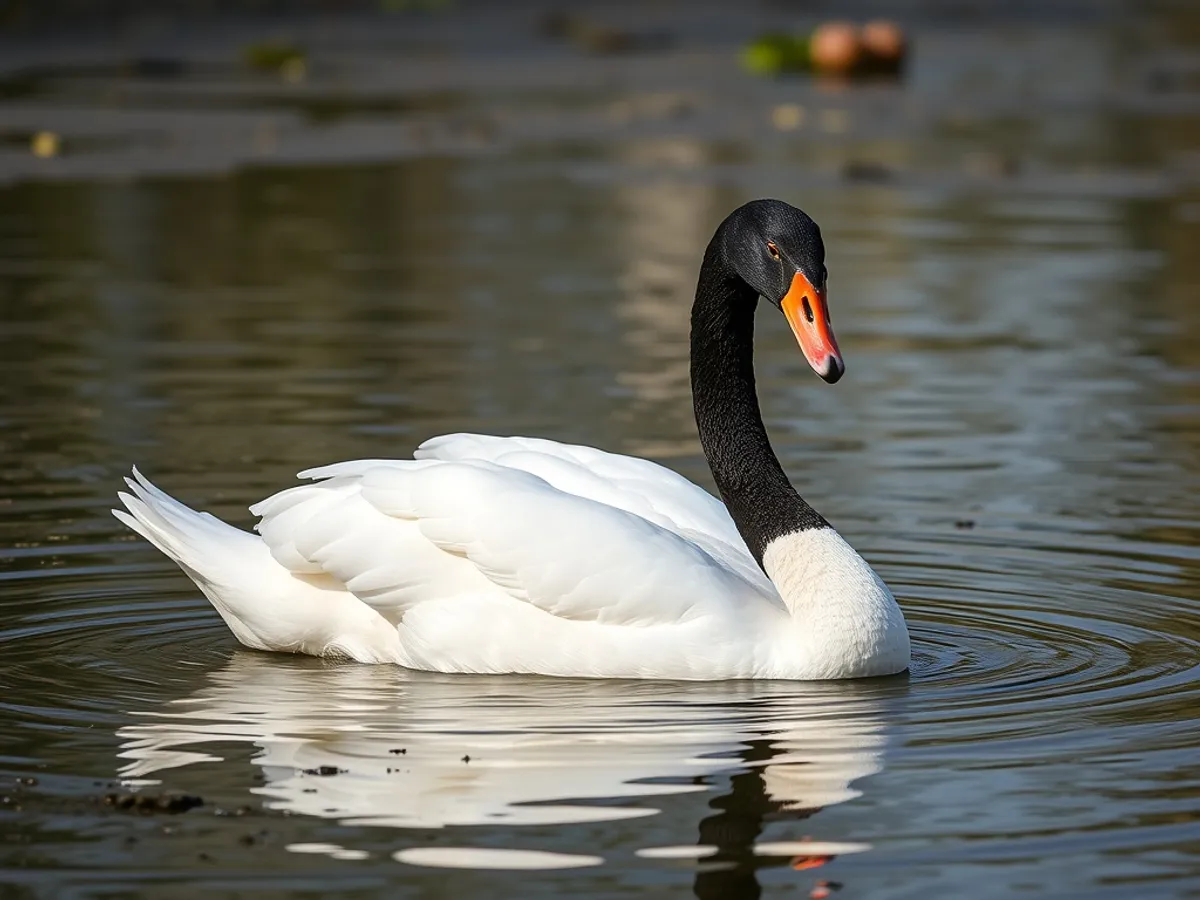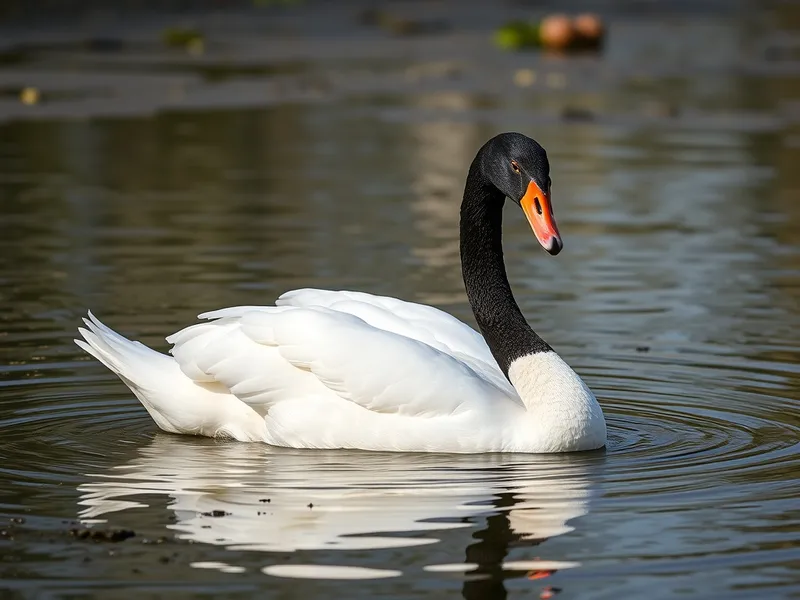
Black-necked Swan
Cygnus melancoryphus

Meet the Black-necked Swan
The Black-necked Swan is the largest waterfowl native to South America, instantly recognizable by its striking black neck, white body, and vivid red knob at the base of its bill. It inhabits freshwater lagoons, marshes, and shallow lakes, often surrounded by dense vegetation. Unlike its northern relatives, it is less migratory and spends most of its life in temperate regions of southern South America. This elegant swan is renowned for its graceful swimming and strong pair bonds, with both parents sharing responsibilities in raising their young.
Classification
Bird
Habitat
Freshwater wetlands
Diet
Herbivore
Lifespan
10-20 years
Conservation
Least Concern
Weight
3.5–6.7 kg
📖Fascinating Facts
Unique Plumage
The Black-necked Swan's combination of a black neck and white body is unique among all swan species.
Cooperative Parenting
Both male and female Black-necked Swans take turns incubating eggs and caring for cygnets after hatching.
Southern Specialist
This swan is native to temperate regions of southern South America, especially Argentina, Chile, Uruguay, and southern Brazil.
📋Detailed Description
The Black-necked Swan (Cygnus melancoryphus) is the largest native waterfowl in South America, with adults typically measuring 102–124 cm in length and weighing between 3.5 and 6.7 kg. Its most distinctive feature is the contrasting coloration: a pure white body set against a long, velvety black neck and head, with a prominent coral-red knob at the base of the bill and a thin white stripe running from the eye to the bill. The bill itself is bluish-gray, and the legs and feet are pinkish. Both sexes are similar in appearance, though males are generally larger and possess a slightly larger knob. The species is highly aquatic, rarely venturing far from water, and is exceptionally adapted for swimming with its short legs positioned far back on the body. Black-necked Swans are known for their graceful movements and strong pair bonds, often seen swimming in pairs or small family groups. Their vocalizations are relatively soft and include a variety of whistles and grunts, as opposed to the loud trumpeting of some northern swan species. They exhibit a high degree of site fidelity, often returning to the same breeding and feeding grounds year after year. During the non-breeding season, they may form loose flocks, but are otherwise territorial during nesting. The species is primarily herbivorous, feeding on aquatic vegetation, algae, and occasionally small invertebrates. Their long necks allow them to forage effectively in deeper water than many other waterfowl.
💡 Did you know?
Unlike most swans, the Black-necked Swan is mute and communicates mainly through soft whistles and grunts.
🔬Research & Sources
Wikipedia Summary
The black-necked swan is a species of waterfowl in the tribe Cygnini of the subfamily Anserinae. It is found in Argentina, Brazil, Chile, Uruguay, and the Falkland Islands.
Last Modified: 1/22/2024
🎭Behavior & Social Structure
Black-necked Swans are diurnal, spending most of the daylight hours foraging and preening. They feed by upending in shallow water or grazing on submerged and emergent aquatic plants, such as pondweeds (Potamogeton spp.), water milfoils (Myriophyllum spp.), and algae. Socially, they are monogamous, forming long-term pair bonds that may last for life. Outside the breeding season, they may gather in flocks of several dozen individuals, especially in rich feeding areas. During the breeding season, pairs become highly territorial and aggressively defend nesting sites from intruders. They communicate through a series of soft whistles, hisses, and grunts, particularly during courtship and when alarmed. Preening is an important part of their daily routine, helping to maintain the waterproof quality of their plumage. Black-necked Swans are strong fliers, though they are generally sedentary, with only local movements in response to water levels or food availability.
👶Reproduction & Life Cycle
Breeding occurs from July to November in the southern part of their range, coinciding with the austral spring and summer. Black-necked Swans are monogamous, with pairs engaging in elaborate courtship displays involving synchronized swimming and mutual preening. Nests are large mounds of vegetation, constructed on islands or among dense reeds in shallow water. The female lays 4–7 creamy-white eggs, which are incubated for 34–36 days, primarily by the female, while the male guards the territory. Both parents are highly attentive, and after hatching, cygnets are precocial, leaving the nest within a day. The parents often carry the young on their backs for protection and warmth during the first few weeks. Fledging occurs at 10–12 weeks, but juveniles may remain with the parents for several months before dispersing.
🛡️Adaptations & Survival
The Black-necked Swan exhibits several adaptations for an aquatic lifestyle, including webbed feet for efficient swimming and a long, flexible neck for foraging underwater. Its dense, waterproof plumage provides insulation in cool temperate climates. The species' relatively quiet vocalizations may reduce predation risk in open wetland habitats. The red knob at the base of the bill is thought to play a role in sexual selection and species recognition. Behavioral adaptations include strong pair bonds and cooperative parental care, which enhance reproductive success. Their ability to exploit both fresh and brackish wetlands allows them to occupy a wide range of habitats.
📚Research Sources
🎨Cultural Significance
The Black-necked Swan holds symbolic value in several South American cultures, often representing grace and fidelity due to its elegant appearance and monogamous nature. In Chile and Argentina, it is featured in local folklore and is sometimes depicted in art and literature. The species is also a flagship for wetland conservation efforts in southern South America, drawing ecotourism and raising awareness about the importance of aquatic ecosystems. There is no significant history of hunting or traditional use, as swans are generally protected and not considered game birds in their native range.
🔬Recent Research & Discoveries
Recent research has focused on the Black-necked Swan's response to environmental changes, particularly in relation to wetland management and water quality. Studies in Chile's Río Cruces wetland have documented population declines linked to the loss of aquatic plants following industrial pollution, highlighting the species' sensitivity to habitat changes. Genetic studies indicate low differentiation across populations, suggesting high gene flow facilitated by local movements. Ongoing monitoring programs track population trends and inform conservation strategies, especially in key breeding areas. The species is also used as a bioindicator for wetland ecosystem health.
🎥Wildlife Videos

Black-necked Swan: A Waterfowl Capable of Flying at Speed of 50 mph
Discover fascinating facts and comprehensive classification regarding black-necked swan. Chapters: 0:00 Introduction 0:11 Facts ...
Animalia

black-necked swan facts
The black-necked swan (Cygnus melancoryphus) is the largest waterfowl native to South America. The body plumage is white ...
Amazing Planet!

Swans – Emblems of Beauty and Devotion Nature's
Graceful, loyal, and mesmerizing — **swans** have captivated the hearts of people for centuries. From their lifelong bonds to their ...
animals wild

One of the most beautiful water birds in the world (Black Necked Swan)
This is the black-necked swan, a bird that inhabits lakes, lagoons and swamps. It is omnivorous, feeding on aquatic plants, seeds, ...
Natural World!

The Graceful World of Swans: Stunning Footage and Facts
The Graceful World of Swans: Stunning Footage and Facts Welcome, This video contains fantastic facts about the Swans Few ...
Eternal Soul

Animal Antidotes: Black-Necked Swan
Animal Antidotes: Zoo Scenes to Remedy Your Day! Today's antidote: Black-Necked Swan! www.zoologicalsocietyofnj.org.
Zoological Society of New Jersey
🌍Habitat Information
The Black-necked Swan typically inhabits Freshwater wetlands environments. Black-necked Swans have adapted to their environments with specialized features and behaviors.
Primary Habitat:
Freshwater wetlands
More detailed habitat information will be available soon.
🛡️Conservation Status
The Black-necked Swan is currently classified as Least Concern. Conservation efforts are crucial for preserving this species for future generations.
Common Threats:
- 🏠Habitat loss and fragmentation
- 🌡️Climate change impacts
- 🎯Hunting and poaching
- 🏭Human-wildlife conflict
⚠️Threats & Conservation Challenges
While currently listed as Least Concern by the IUCN, Black-necked Swans face several localized threats. Habitat loss and degradation due to wetland drainage, water pollution, and agricultural expansion are significant concerns, particularly in the Pampas and Patagonian regions. In some areas, lead poisoning from spent ammunition and ingestion of toxic algae have caused mortality events. Human disturbance, such as boating and recreational activities, can disrupt breeding and feeding. Climate change poses a long-term threat by altering wetland hydrology. Despite these challenges, the species maintains stable populations in much of its range, though some local declines have been noted.
🔬Scientific Classification
Scientific Name
Cygnus melancoryphus
Classification Hierarchy
🔍 About Taxonomic Classification
Taxonomic classification is a hierarchical system used by scientists to classify and organize living organisms based on shared characteristics and evolutionary relationships.
The system moves from broad categories (Kingdom) to increasingly specific ones, with each animal's scientific name typically consisting of its Genus and species.
📝Community Notes
Share your observations and insights about the Black-necked Swan with our community of wildlife enthusiasts.
Join Our Community
Sign in to share your observations and connect with fellow wildlife enthusiasts.
Sign In to ContributeNo community notes yet
Be the first to share your observations about the Black-necked Swan!
Explore Black-necked Swan
Select a tab above to learn more about this amazing animal.
📸Photo Gallery
No photos available for this animal yet.
🌟Discover More Wildlife
Continue your journey of discovery with more fascinating animals from our database
